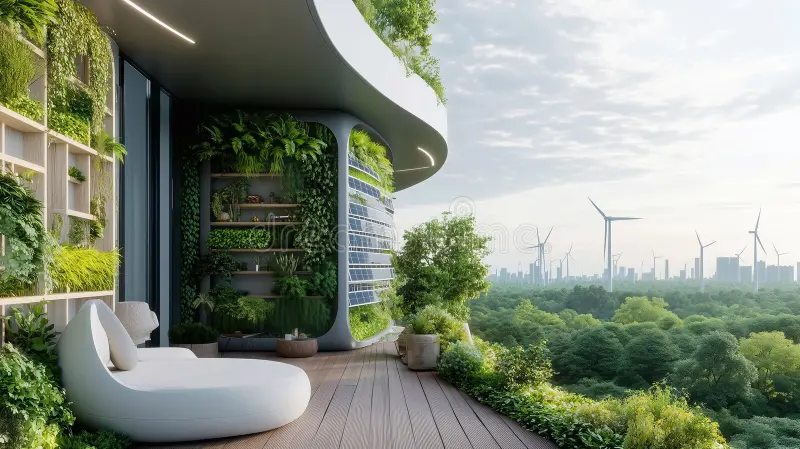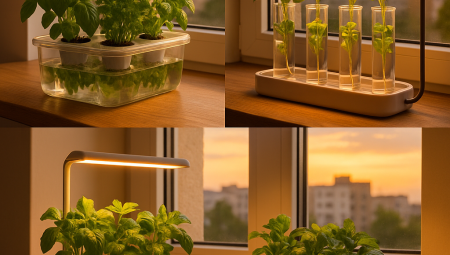Are you an urban dweller with a passion for green living, but limited by a tiny balcony? You’re not alone. As city populations swell and the desire for fresh, homegrown produce intensifies, sustainable urban gardening for small balconies has emerged as a crucial solution. In 2025, it’s more than just a hobby; it’s a commitment to environmental stewardship, food security, and personal well-being. This comprehensive guide will show you exactly how to transform your compact outdoor space into a thriving, eco-friendly haven, ensuring you not only maximize your yield but also minimize your ecological footprint. Get ready to cultivate your own little slice of sustainable paradise, right outside your door!
The Rise of the Balcony Farmer: Why Sustainable Urban Gardening Matters Now More Than Ever
The allure of growing your own food is undeniable. For city residents, however, the challenge of space often seems insurmountable. Yet, the demand for locally sourced, organic produce, coupled with growing environmental consciousness, has propelled sustainable urban gardening for small balconies into the spotlight. In fact, recent data from the National Gardening Association indicates a 15% increase in container gardening participation in urban areas since 2023, with a significant shift towards sustainable practices. This trend isn’t just about growing food; it’s about reconnecting with nature, reducing carbon emissions associated with food transport, and fostering community resilience. Your small balcony isn’t a limitation; it’s an opportunity to contribute to a greener, more sustainable future.
What is Sustainable Urban Gardening?
Sustainable urban gardening goes beyond simply planting seeds. It encompasses a holistic approach that focuses on ecological balance, resource conservation, and long-term viability within an urban context. For small balconies, this means optimizing every inch, choosing the right plants, managing water efficiently, and enriching soil naturally – all while minimizing waste and reliance on external inputs. It’s about creating a miniature ecosystem that thrives with minimal intervention.
Unlocking Your Balcony’s Full Potential: Essential Pillars for Eco-Friendly Growth
Transforming your small balcony into a productive, sustainable garden requires strategic planning and innovative solutions. Here are the core pillars to guide your journey:
1. Smart Space Utilization: Vertical, Modular, and Repurposed Solutions
The cardinal rule of small-space gardening is to think vertically. Every square foot of floor space on your balcony is precious, but the airspace above it offers immense potential.
Optimizing Verticality with Innovative Planters
- Vertical Planters and Wall Gardens: These are game-changers for small balconies. Systems ranging from simple hanging pouches to sophisticated self-watering wall units allow you to grow a diverse array of herbs, leafy greens, and even strawberries without taking up floor space. Look for modular designs that can be expanded as your garden grows.
- Tiered Shelving Units: Sturdy, weather-resistant shelves can hold multiple pots, maximizing your plant count per footprint. Opt for units with adjustable shelves to accommodate plants of varying heights.
- Hanging Baskets: Ideal for trailing plants like cherry tomatoes, petunias, or nasturtiums, hanging baskets utilize overhead space effectively. Ensure they are securely mounted to prevent accidents.
Embracing Modularity and Repurposing
- Modular Containers: Choose pots and containers that fit together efficiently, allowing for easy rearrangement and expansion. Self-watering containers are particularly beneficial as they reduce water waste and the frequency of watering.
- Creative Repurposing: Before buying new, look around! Old wooden pallets can be transformed into vertical planters. Discarded plastic bottles can become drip irrigation systems. Even old tires, with proper preparation, can house sturdy plants. Repurposing not only saves money but also significantly reduces waste, aligning perfectly with sustainable principles.
2. Water Conservation: The Lifeline of Your Balcony Garden
Water is a finite resource, and efficient irrigation is a cornerstone of sustainable urban gardening for small balconies. Minimizing water waste is not only eco-friendly but also crucial for plant health in confined spaces where evaporation can be high.
Strategic Watering Techniques
- Morning Watering: Water your plants in the early morning. This allows the roots to absorb water before the sun’s heat causes excessive evaporation, reducing water loss by up to 30% compared to midday watering.
- Deep, Infrequent Watering: Instead of light daily sprinkles, water deeply until water drains from the bottom of the pot. This encourages roots to grow deeper, making plants more resilient to dry spells.
- Moisture Meters: For beginners, a simple moisture meter can prevent over or under-watering, ensuring your plants receive just the right amount of hydration.
Innovative Water-Saving Systems
- Drip Irrigation Systems: Even on a small scale, a DIY or miniature drip irrigation system can be incredibly efficient. These systems deliver water directly to the plant’s root zone, minimizing evaporation and runoff. You can easily create a basic system using recycled plastic bottles with small holes.
- Self-Watering Planters: These containers have a reservoir at the bottom that wicks water up to the soil as needed, significantly reducing water consumption and watering frequency. They are especially useful for busy urban gardeners.
- Rainwater Harvesting: If feasible, set up a small rain barrel or collection system to capture rainwater. Rainwater is free from chlorine and other chemicals found in tap water, making it excellent for plants. Even a small bucket strategically placed can collect surprising amounts of water.
3. Soil Health and Nutrient Cycling: Feeding Your Plants Naturally
The soil in your containers is your plants’ entire universe. Unlike garden beds, container soil doesn’t naturally replenish nutrients from the surrounding environment. Therefore, maintaining its health through organic and sustainable methods is vital.
Choosing the Right Medium
- Organic Potting Mixes: Always start with high-quality, organic potting mix. Look for mixes that contain beneficial microbes, compost, and perlite for good drainage and aeration. Avoid mixes with synthetic fertilizers or peat moss from unsustainable sources.
- DIY Potting Mix: For a truly sustainable approach, create your own mix using compost, coco coir (a sustainable alternative to peat), perlite, and a dash of worm castings.
Embracing Composting and Vermicomposting
- Small-Scale Composting: If you have space, a compact countertop composter or a small tumbling composter can turn kitchen scraps into valuable compost.
- Vermicomposting (Worm Composting): This is ideal for balconies. A small worm bin (often disguised as a decorative bin) can efficiently convert fruit and vegetable scraps into nutrient-rich worm castings and “worm tea,” a potent liquid fertilizer. It’s odorless when managed correctly and a fantastic way to eliminate food waste.
- Natural Fertilizers: Supplement your soil with organic amendments. Diluted compost tea, coffee grounds (for acid-loving plants), crushed eggshells (for calcium), and banana peels (for potassium) are excellent, free sources of nutrients. Avoid chemical fertilizers which can harm beneficial soil microbes and leach into water systems.
4. Integrated Pest Management (IPM): Protecting Your Plants Naturally
Chemical pesticides have no place in a sustainable balcony garden. They harm beneficial insects, contaminate produce, and pollute the environment. Integrated Pest Management (IPM) focuses on prevention and natural controls.
Proactive Prevention
- Healthy Plants: Strong, well-fed plants are naturally more resistant to pests.
- Regular Inspection: Inspect your plants daily for early signs of pests. Catching an infestation early makes it much easier to control.
- Good Air Circulation: Proper spacing between plants helps prevent fungal diseases.
Natural Pest Control Methods
- Beneficial Insects: Encourage natural predators like ladybugs, lacewings, and hoverflies. You can purchase them or attract them by planting their favorite flowers.
- Companion Planting: Certain plants naturally deter pests. Marigolds deter nematodes, while nasturtiums can act as a “trap crop,” luring aphids away from other plants.
- Homemade Sprays: For minor infestations, a simple spray of diluted neem oil or insecticidal soap (made from mild dish soap and water) can be highly effective against aphids, spider mites, and whiteflies.
- Manual Removal: For larger pests like slugs or caterpillars, simply pick them off by hand.
5. Smart Plant Selection: Matching Plants to Your Balcony’s Conditions
Choosing the right plants for your specific balcony conditions is critical for success. Not all plants thrive in containers, and not all balconies receive the same amount of sunlight.
Assessing Your Balcony’s Microclimate
- Sunlight: Observe how many hours of direct sunlight your balcony receives.
- Full Sun (6+ hours): Tomatoes, peppers, herbs (basil, oregano), strawberries, most vegetables.
- Partial Sun (3-6 hours): Leafy greens (lettuce, spinach, kale), bush beans, some herbs (mint, cilantro).
- Shade (less than 3 hours): Few edibles thrive, but some herbs like mint and parsley can tolerate it. Focus on ornamental shade-loving plants.
- Wind Exposure: Windy balconies require sturdy containers and potentially windbreaks to protect delicate plants.
- Temperature Fluctuations: Balconies can heat up quickly in summer and get very cold in winter. Choose varieties suited to your local climate zone.
Ideal Plants for Small Balconies
- Compact Varieties: Look for dwarf, bush, or patio varieties of vegetables and fruits specifically bred for container growing.
- Vegetables: “Patio” tomatoes, bush beans, dwarf carrots, radishes, mini bell peppers, eggplants.
- Leafy Greens: Lettuce, spinach, kale, Swiss chard – these are excellent for continuous harvesting.
- Herbs: Basil, mint, chives, rosemary, thyme, oregano – most herbs thrive in pots.
- Fruits: Alpine strawberries, dwarf blueberries (require acidic soil), small citrus trees.
- Perennials vs. Annuals: Consider growing perennial herbs and small fruit bushes that return each year, reducing the need for annual replanting.
6. Crop Rotation and Succession Planting: Maximizing Yield and Soil Health
Even in small containers, practicing principles like crop rotation and succession planting can significantly boost your yield and maintain soil health over time.
- Mini Crop Rotation: While full-scale crop rotation is challenging in containers, you can rotate the types of plants you grow in specific pots. For instance, after growing a “heavy feeder” like a tomato plant in one pot, plant a “light feeder” like lettuce or a legume (which adds nitrogen) in the same pot next season. This prevents nutrient depletion.
- Succession Planting: Instead of planting all your seeds at once, sow small batches of quick-growing crops (like lettuce, radishes, or spinach) every few weeks. This ensures a continuous harvest rather than a single large one, perfect for consistent fresh produce on a small scale.
7. Composting and Waste Reduction: Closing the Loop
The most fundamental aspect of sustainable gardening is minimizing waste and maximizing resource utilization. On a small balcony, this means being particularly mindful of your inputs and outputs.
- DIY Potting Mix: As mentioned, creating your own potting mix reduces reliance on store-bought bags and ensures you know exactly what’s in your soil.
- Mulching: Add a layer of mulch (shredded leaves, straw, or wood chips) to the top of your container soil. Mulch helps retain moisture, suppresses weeds, and regulates soil temperature, ultimately reducing water consumption and the need for weeding.
- Tool Longevity: Invest in durable, high-quality gardening tools that will last for years, rather than cheap ones that quickly break and end up in landfills. Maintain them well.
- Seed Saving: If you grow open-pollinated (non-hybrid) varieties, consider saving seeds from your healthiest plants. This reduces costs and fosters self-sufficiency.
Featured Snippet Optimization: Your Quick Guide to Thriving Balcony Greens
How to Start a Sustainable Urban Garden on a Small Balcony in 2025?
Starting a sustainable urban garden on a small balcony in 2025 involves prioritizing space-saving solutions, water conservation, and organic practices. Begin by assessing your balcony’s sunlight and wind conditions. Choose compact plant varieties suited to your light levels, like cherry tomatoes or leafy greens. Utilize vertical planters, hanging baskets, and repurposed containers to maximize space. Implement efficient watering techniques like drip irrigation or self-watering pots. Enrich your soil with homemade compost or worm castings, and use natural pest control methods to maintain a healthy, eco-friendly garden.
Pro Tips for the Urban Balcony Gardener
- Start Small: Don’t try to grow everything at once. Begin with a few easy-to-grow herbs or leafy greens to build confidence.
- Observe and Learn: Pay close attention to your plants. They will tell you what they need through their leaves, growth patterns, and overall health.
- Community Connection: Join local urban gardening groups or online forums. Sharing experiences and tips with others can be incredibly valuable.
- Embrace Imperfection: Not every plant will thrive, and that’s okay. Gardening is a continuous learning process.
- Automate When Possible: For busy schedules, consider smart irrigation systems or self-watering planters to ensure consistent care.
- Winter Protection: For perennial plants, research simple winter protection methods like wrapping pots or bringing them indoors if your climate demands it.
Frequently Asked Questions (FAQ)
Q1: What are the best plants for a beginner’s sustainable balcony garden?
For beginners, easy-to-grow herbs like basil, mint, and chives are excellent choices, as are leafy greens like lettuce, spinach, and kale. Radishes and cherry tomatoes (dwarf varieties) also tend to be forgiving and provide quick rewards, boosting confidence. These plants are relatively low-maintenance and don’t require extensive space or complex care.
Q2: How can I compost on a small balcony without odors?
The most effective way to compost on a small balcony without odors is through vermicomposting, using a worm bin. When properly managed with the correct balance of “greens” (food scraps) and “browns” (shredded paper, cardboard), worm bins are virtually odorless. Ensure the bin has good airflow and avoid adding meat, dairy, or oily foods, which can cause smells and attract pests.
Q3: Is it cheaper to grow my own food on a balcony?
Initially, there might be a small upfront cost for containers, soil, and seeds. However, in the long run, growing your own produce can be significantly cheaper, especially for common items like herbs, lettuce, and tomatoes. Beyond monetary savings, you also gain the benefits of fresh, organic, pesticide-free food, reducing your reliance on supermarket supply chains and their associated environmental costs.
Q4: How often should I water my balcony plants sustainably?
The frequency of watering depends on the plant type, pot size, soil mix, and weather. Instead of a fixed schedule, check the soil moisture daily by sticking your finger an inch or two into the soil. If it feels dry, it’s time to water. Utilize self-watering planters or drip irrigation systems to deliver water directly to the roots, minimizing evaporation and ensuring optimal hydration.
Q5: Can I grow vegetables on a north-facing balcony?
Growing vegetables on a north-facing balcony, which receives less direct sunlight, is challenging but not impossible. You’ll need to focus on shade-tolerant crops like leafy greens (lettuce, spinach, kale), some herbs (mint, parsley, cilantro), and root vegetables (radishes, carrots) if they can get a few hours of indirect light. Fruiting vegetables like tomatoes and peppers typically require full sun.
Conclusion: Your Sustainable Balcony Oasis Awaits
Embracing sustainable urban gardening for small balconies is a journey of growth, discovery, and profound connection to the natural world, even in the heart of the city. By implementing smart space solutions, conserving precious water, nourishing your soil naturally, and protecting your plants with eco-friendly methods, you’re not just growing food; you’re cultivating a lifestyle. This 2025, transform your balcony into a vibrant, productive, and sustainable oasis that reflects your commitment to a greener planet.
What are your biggest challenges or successes with sustainable balcony gardening? Share your thoughts and tips in the comments below!



